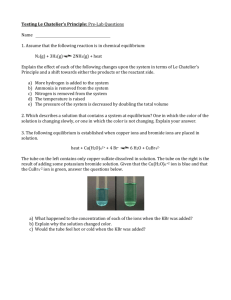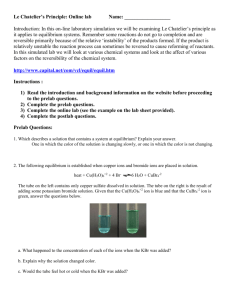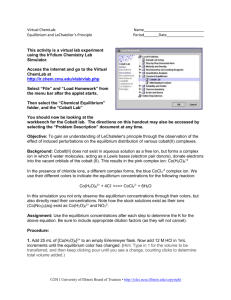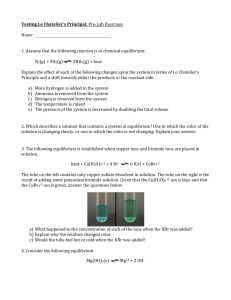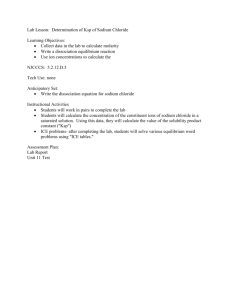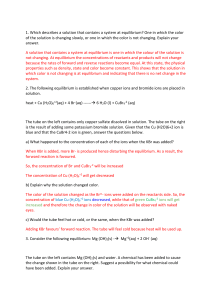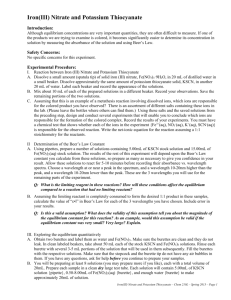Virtual Lab – Equilibrium & LeChatelier`s Principle
advertisement
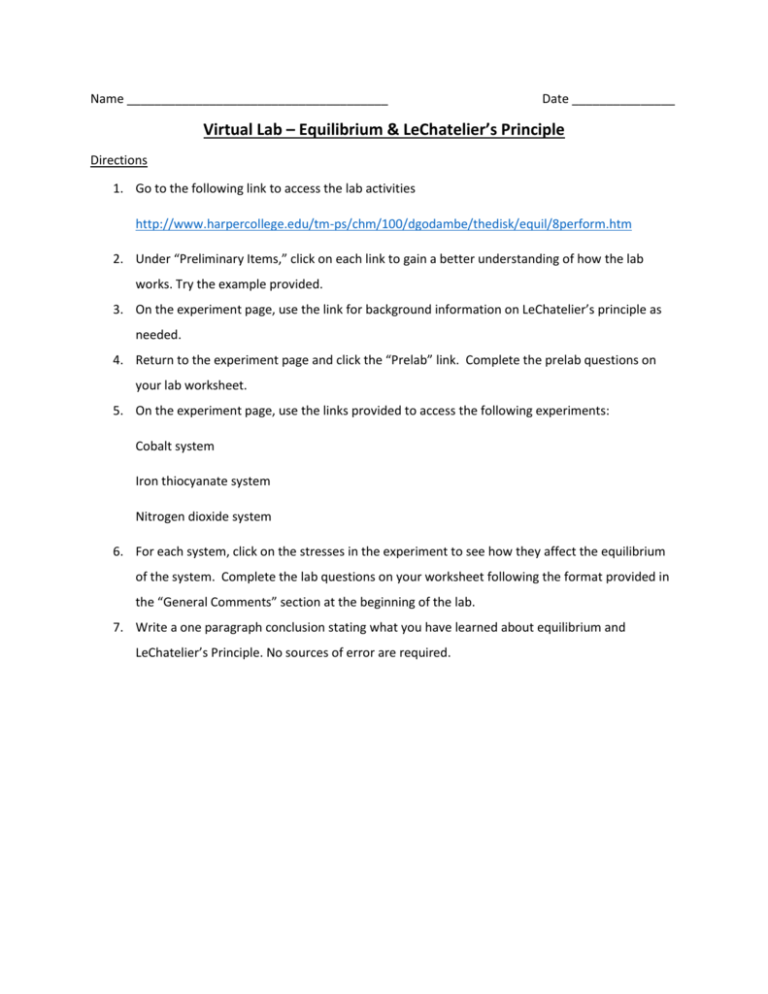
Name ______________________________________ Date _______________ Virtual Lab – Equilibrium & LeChatelier’s Principle Directions 1. Go to the following link to access the lab activities http://www.harpercollege.edu/tm-ps/chm/100/dgodambe/thedisk/equil/8perform.htm 2. Under “Preliminary Items,” click on each link to gain a better understanding of how the lab works. Try the example provided. 3. On the experiment page, use the link for background information on LeChatelier’s principle as needed. 4. Return to the experiment page and click the “Prelab” link. Complete the prelab questions on your lab worksheet. 5. On the experiment page, use the links provided to access the following experiments: Cobalt system Iron thiocyanate system Nitrogen dioxide system 6. For each system, click on the stresses in the experiment to see how they affect the equilibrium of the system. Complete the lab questions on your worksheet following the format provided in the “General Comments” section at the beginning of the lab. 7. Write a one paragraph conclusion stating what you have learned about equilibrium and LeChatelier’s Principle. No sources of error are required. Pre-lab Questions 1. Which describes a solution that contains a system at equilibrium? Explain your answer. One in which the color of the solution is changing slowly, or one in which the color is not changing. 2. The following equilibrium is established when copper ions and bromide ions are placed in solution. heat + Cu(H2O)6+2 + 4 Br- 6 H2O + CuBr4-2 The tube on the left contains only copper sulfate dissolved in solution. The tube on the right is the result of adding some potassium bromide solution. Given that the Cu(H2O)6+2 ion is blue and that the CuBr4-2 ion is green, answer the questions below. a. What happened to the concentration of each of the ions when the KBr was added? b. Explain why the solution changed color. c. Would the tube feel hot or cold when the KBr was added? Why? 3. Consider the following equilibrium. Mg+2 + 2 OH- Mg(OH)2(s) The tube on the left contains Mg(OH)2(s) and water. A chemical has been added to cause the change shown in the tube on the right. Suggest a possibility for what chemical could have been added. Hint: What might decrease the concentration of OH- ions? 4. Methanol has the formula CH3OH and can be produced by the reaction of carbon monoxide with hydrogen gas. CO + 2 H2 CH3OH + heat In an attempt to maximize the yield of methanol (amount of methanol produced), a chemist would try to shift the equilibrium as far to the right as possible. Which of the following would accomplish this? a. heating the mixture b. adding an excess of carbon monoxide c. removing the methanol as it is formed d. adding a substance that reacts with carbon monoxide Lab Experiment Questions Cobalt System 1. Stress _________________________________________________________________________ a) Observation – b) Explanation – 2. Stress _________________________________________________________________________ a) Observation – b) Explanation – 3. Stress _________________________________________________________________________ a) Observation – b) Explanation – 4. Stress _________________________________________________________________________ a) Observation – b) Explanation – 5. Stress _________________________________________________________________________ a) Observation – b) Explanation – Iron thiocyanate System 1. Stress __________________________________________________________________________ a) Observation – b) Explanation – 2. Stress _________________________________________________________________________ a) Observation – b) Explanation – 3. Stress _________________________________________________________________________ a) Observation – b) Explanation – 4. Stress _________________________________________________________________________ a) Observation – b) Explanation – Nitrogen dioxide system 1. Stress _________________________________________________________________________ a) Observation – b) Explanation – 2. Stress _________________________________________________________________________ a) Observation – b) Explanation -
